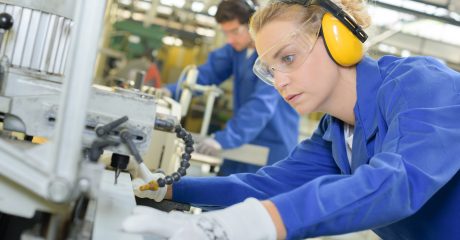Though the industry is predominantly men, women have been working in manufacturing and machining for longer than you might think. This Mother’s Day, let’s take a look at the history of women in machining and manufacturing.
The Impact of Women in Machining and Manufacturing
Many of the industry norms we know today could not have existed without women in machining. Although we don’t tend to think about it very often. What are some things we wouldn’t have as they are in the field without women? For starters, we’d be lacking in safety devices, the synthetic fabric kevlar, and even brown paper bags.
Those may seem random, or even inconsequential, but they are nonetheless a part of machining and manufacturing’s long history and all contribute to American industry as it stands today.
Margaret Knight
Before she was even a teenager Margaret Knight developed an invention with widespread use in virtually every modern day mill and she is one of the most influential women in machining. While working in a textile mill at the age of 12, she witnessed an accident that injured another worker. That inspired her to create a safety check that would automatically turn off a machine if something was stuck in it. This protocol is a feature in nearly all machines nowadays, but in the 1800s those safety checks were hardly commonplace.
Her most popular invention, however, was a machine that folded and then glued flat paper bottoms. That’s right, the brown paper bags still used across the world. Prior to her invention, the bottoms of these bags were not flat and packing them was way more complicated. Her machine design is still in use in paper bag manufacturing plants today. Knight would continue to invent nearly 100 more products and machining parts throughout her life.
Stephanie Kwolek
You might not know her name, but you’ve probably heard of her invention. She created a synthetic fiber that was a strong as steel, is flame and corrosion resistant and holds up to wear and impact—Kevlar. It’s a product that changed the world. Through its use in bulletproof vests it has protected the lives of our police force, military, and civilian personnel in a way we were incapable of before. In addition to bulletproof vests, Kevlar is also used in suspension bridge cables, safety helmets, hiking and camping gear and even skis.
Madame C.J. Walker
Walker became one of the first self-made billionaire women in America through founding her own manufacturing company for African American hair care. Through personal experimentation, Walker created her own hair care products and knew they would be useful for other women. She eventually came to own her own factory, trained her sales agents to also be beauticians and employed thousands of women. She created her brand from the ground up and every step of the way. She conducted her own chemical experiments to create her product, built the factories that made them and trained salespeople and customers to use them. Madame C.J. Walker was a pioneer every step of the way and a true representative of the American Dream.
